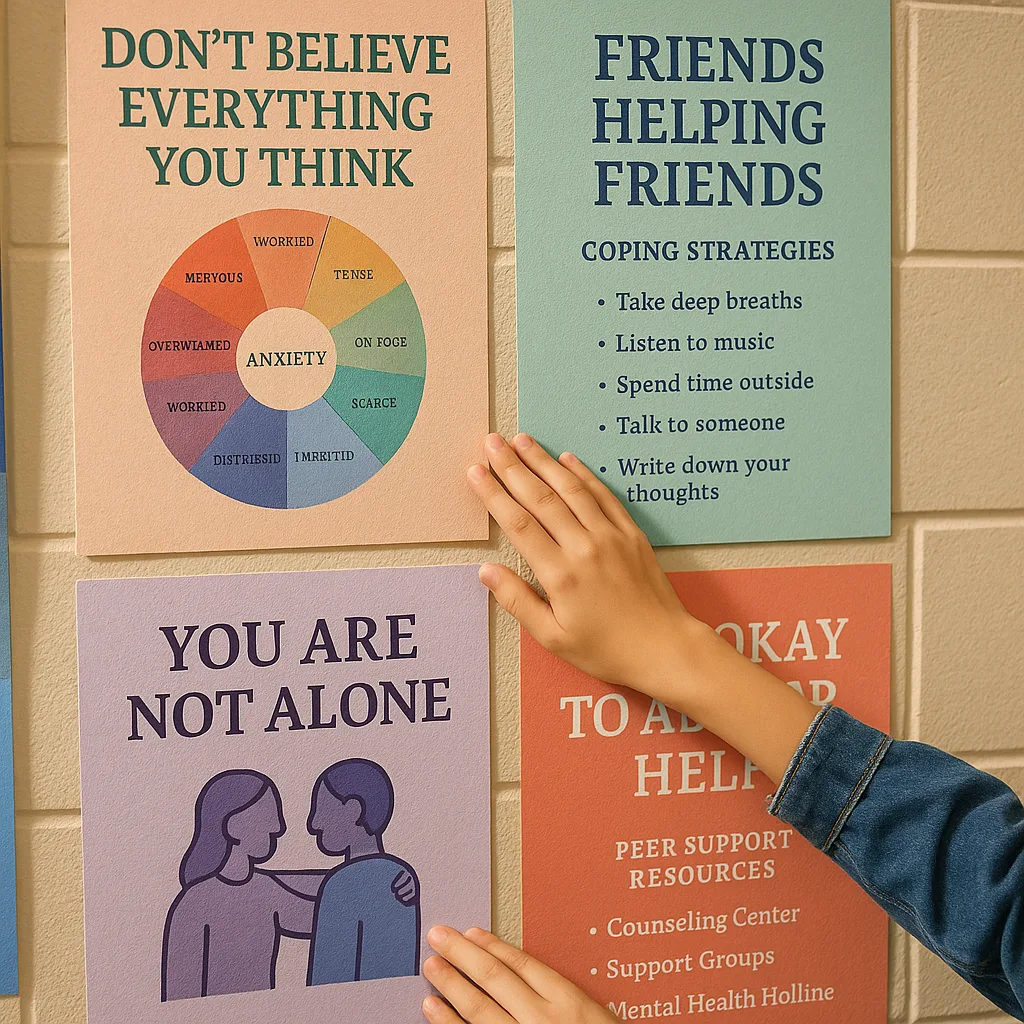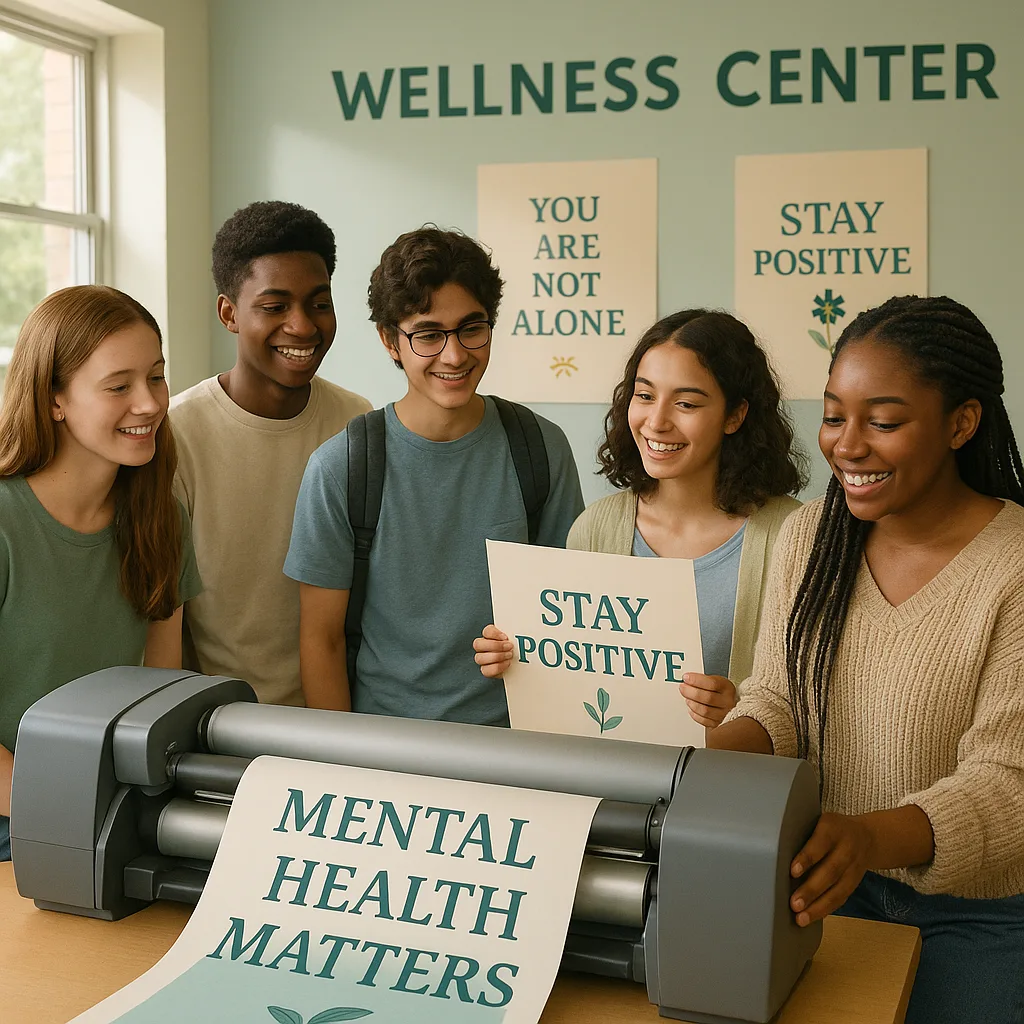Poster Printers for Schools Mental Health
After twelve years of working with schools to develop comprehensive wellness programs, I’ve witnessed the transformative impact of peer-to-peer mental health initiatives. When we place creative tools like a school poster maker machine in students’ hands, we’re not just teaching design skills—we’re cultivating a generation of mental health advocates who understand their peers’ struggles intimately.
The Research Behind Peer Support Visual Networks
Recent studies from the Journal of School Psychology demonstrate that peer-delivered mental health messages increase help-seeking behaviors by 40% compared to adult-led campaigns. When students see mental health posters created by their classmates, they report feeling more understood and less isolated. This peer-to-peer approach, supported by visual communication tools, creates what researchers call “horizontal health promotion”—wellness messaging that moves laterally through social networks rather than top-down from authority figures.
Furthermore, a 2023 meta-analysis published in Clinical Child Psychology Review found that schools implementing student-designed mental health campaigns saw a 32% reduction in reported stigma around counseling services. These statistics underscore why investing in creative tools for student expression isn’t just nice to have—it’s essential for comprehensive school wellness.

Setting Up Age-Appropriate Design Workshops
Creating effective peer support networks through visual design requires careful scaffolding based on developmental stages. Here’s how to structure workshops that honor students’ capabilities while pushing creative boundaries:
Elementary Level (Grades 3-5): Building Emotional Vocabulary
At this stage, focus on helping students identify and express emotions visually. Using tools like the Classroom Pro 24 Poster Maker Elite Package, guide students to create simple posters featuring:
• Emotion wheels with colors and faces
• “Feelings forecast” posters showing emotional weather patterns
• Kindness reminder cards with affirming messages
• Friendship recipe posters highlighting social skills
Keep sessions to 30-45 minutes with built-in movement breaks. Provide emotion word banks and simple design templates while encouraging personal touches.
Middle School (Grades 6-8): Addressing Identity and Belonging
Middle schoolers grapple with identity formation and peer acceptance. Design workshops should acknowledge these developmental needs while promoting inclusive messaging:
• Identity affirmation posters celebrating diversity
• “You belong here” campaigns featuring student photos and stories
• Stress-management technique infographics
• Anti-bullying visual narratives
Sessions can extend to 60-75 minutes, incorporating peer feedback loops and collaborative design elements. The poster printing process becomes a metaphor for making internal experiences visible and validated.
The Amplify Poster Maker empowers student creativity
of students report feeling more comfortable discussing mental health after participating in peer poster campaigns
Implementing Effective Peer Review Processes
Step 1: Gallery Walks
Students display draft posters around the room for anonymous peer feedbackCreating Safe Spaces
Set up poster drafts with sticky notes nearby. Peers write supportive suggestions and affirmations, focusing on message clarity and emotional impact rather than artistic skill.Step 2: Small Groups
3-4 students share designs and discuss messaging effectivenessCollaborative Refinement
Facilitate structured conversations using prompts: “This poster makes me feel…” “The message would be clearer if…” “I especially connect with…”Step 3: Final Review
Student wellness team reviews for accuracy and appropriatenessQuality Assurance
Trained peer leaders ensure messages align with school values, include proper resources, and maintain sensitivity to all community members.Addressing Sensitive Topics Responsibly
When students create mental health awareness materials, certain topics require extra care. Establish clear guidelines that balance creative expression with community safety:
Topics requiring adult consultation:
• Suicide prevention messaging
• Eating disorder awareness
• Self-harm discussions
• Trauma-related content
Train student leaders to recognize when professional input strengthens their message. Having a school poster maker machine on campus means rapid prototyping—students can refine sensitive messages with counselor feedback before final printing.
Measuring Impact and Celebrating Success
Impact metrics from schools using peer-designed mental health campaigns
Creating a Sustainable Peer Support Culture
The true measure of success isn’t just in beautiful posters—it’s in the conversations they spark. When a struggling student sees a peer-created poster about anxiety management and thinks, “Someone like me understands,” we’ve achieved our goal. This requires ongoing commitment to several key principles:
1. Regular Training Cycles: Schedule quarterly workshops to onboard new student designers and refresh skills. Each session should introduce new mental health topics based on current school climate needs.
2. Diverse Representation: Actively recruit students from all social groups, academic levels, and backgrounds. The poster campaigns should reflect your school’s full diversity.
3. Professional Partnerships: Connect with local mental health organizations for content accuracy and resource sharing. Many will provide free consultation for student initiatives.
4. Documentation and Assessment: Track help-seeking behaviors through counseling office visits, peer support group attendance, and anonymous surveys. Use data to refine messaging strategies.
5. Celebration and Recognition: Host semester-end exhibitions showcasing student mental health posters. Invite families and community members to witness youth advocacy in action.
Bringing It All Together
Creating visual peer support networks through student-designed mental health posters represents more than a creative project—it’s a paradigm shift in how we approach school wellness. By trusting young people with poster printers for schools mental health messaging, we acknowledge their expertise in reaching their peers while building essential life skills in communication, empathy, and advocacy.
Remember, every poster created is a conversation started, a stigma challenged, and a hand extended to someone who might be struggling in silence. The investment in tools like a quality school poster maker machine pays dividends not just in vibrant hallway displays, but in lives touched and potentially saved through peer connection.
As we continue nurturing these visual peer support networks, we’re not just decorating walls—we’re building bridges between isolated students and the help they need. That’s the true power of placing creative tools in young hands and trusting them to care for one another.


